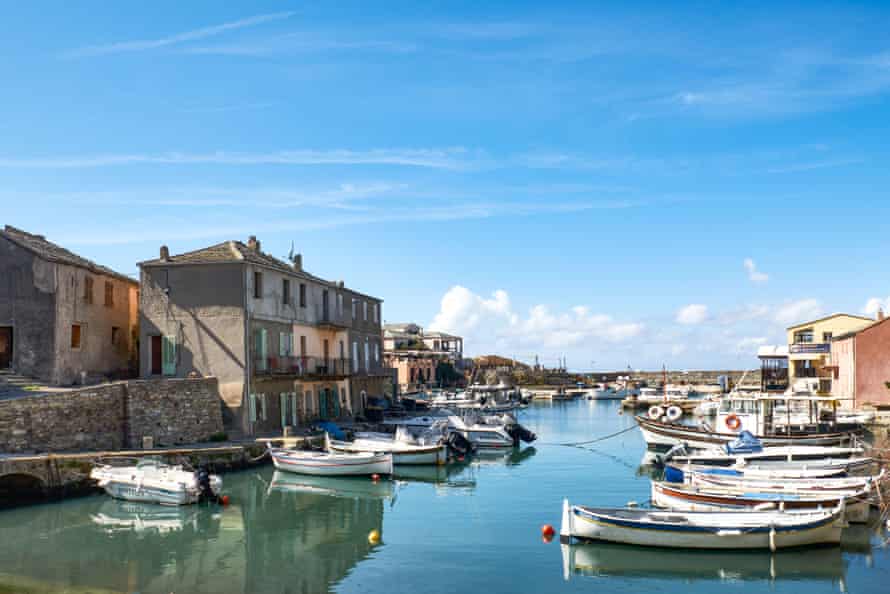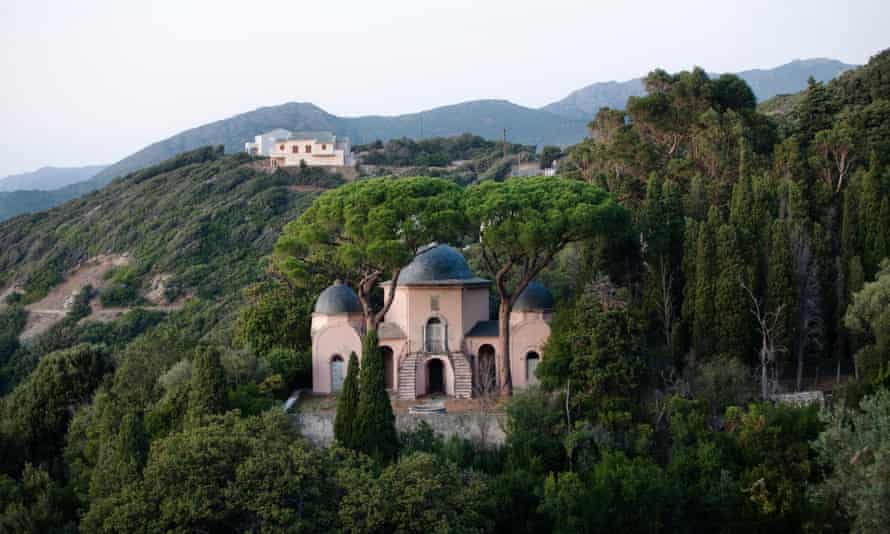It takes a while to register the bullet holes that decorate each signpost along the high road out of Ajaccio, Corsica’s capital. Maybe it’s the distracting octogenarian tailgating wildly in his battered Renault van, or a lack of sleep courtesy of the overnight ferry from Toulon, but as we climb high into the country’s soaring central mountain range, it becomes impossible to ignore the omnipresent, disfigured signposts. Perhaps I shouldn’t have been surprised, given Corsica’s surprisingly violent (surprisingly recent) past.
This year my wife, Tess, and I decide to avoid airports, pack the car and hit the road for our holiday. No-fly vacations are seeing a boom in popularity. Increasing awareness of the Earth’s fragility combined with the pandemic’s influence on global travel has seen holidaymakers switch to the road and rail networks, and since 2020 the Global Sustainable Tourism Council has noted a marked move “towards ‘slow’ travel by car and train”.
Travelling by car also means the dog can come. Corsica is the nearest, hottest, most affordable option, so we take the Eurotunnel to Calais and point the car south for our crossing from Toulon to Ajaccio.
Choosing to drive rather than fly reduces the holiday’s CO2 footprint, but there are other benefits to taking the slow route. The journey becomes part of the adventure, we see more of France and – for the first time in 18 months – we are masters of our own destiny; it’s hugely restorative.
We stay overnight at Nuits-Saint-Georges, in Burgundy. Some of the world’s most famous wines are crafted within a few acres of this small town among steep hills coated in ripening vines. At the unassuming Hôtel-Bar de l’Étoile, we enjoy a cold beer, a bottle of Château de Premeaux from just down the road, and a fantastic boeuf bourguignon.
The next day we push on south, the temperature increasing as our latitude decreases and the traffic building as we edge past Lyon, Orange and into the more arid landscape of Provence. The scent of pine resin, baked asphalt and salty air greet our arrival at the Mediterranean, before our overnight ferry from Toulon to Ajaccio.
Our ultimate destination is Cap Corse, the finger-like, 25-mile promontory that thrusts north into the Ligurian Sea at the top of the island. The journey from Ajaccio is an introduction to the Corsican driving style, a flamboyant mix of French and Italian influences. At Corte, a nasty accident on the same strip of tarmac that witnessed Henri Toivonen’s fatal rally incident in 1986 during the Tour de Corse causes a huge jam. Toivonen’s crash became one of the most famous (and mysterious) in motorsport, and ultimately contributed to the ending of rallying’s high-speed Group B class.

We detour via Saint-Florent to avoid the worst of the tailback. It’s an ancient fishing port with a commanding citadel and floods of tourists. This is wine country, and at Domaine Bazzarini we buy five litres of rosé from a petrol-style pump for €12.50. It is rustic, and delicious.
Cap Corse is just round the corner, so with difficulty we stop admiring our rosé and head for the tiny fishing port of Marine de Scalo, below the village of Pino, where we have an Airbnb for the fortnight. Like much of Corsica, Cap Corse feels old and, despite the stunning scenery, there’s an ancient presence to the craggy, dramatic country that feels ominous, brooding and even savage. Bullet holes start appearing in the signposts again.
Corsica’s unique history created a breeding ground for violence based on an ancient honour code, and the vendetta campaigns and banditry that plagued the island for centuries were the result. The vendettas, which cost tens of thousands of Corsican lives, were largely managed out by the French government by the mid-19th century, but the last bandit, a murderer called Muzarettu, died as recently as 1952. After a life spent hiding from justice in the maquis, Corsica’s fragrant bush land, he slipped quietly into one of the island’s numerous Franciscan monasteries, made his peace with God and died of facial cancer, the only adversary he failed to outrun.
Cap Corse has something for everyone, and most places are within a 45-minute drive. A car is essential for getting about (the island’s scenic railway does not extend beyond Bastia), and you’ll need cash pretty much everywhere.

Centuri, a small fishing port, boasts a wealth of seafood restaurants around a small harbour (we had a great lunch at Le Langoustier). Gastronomes may prefer Michelin-starred Le Pirate in Erbalunga. In the same village is the charming, old-world Hôtel Castel Brando, which we discovered by accident when seeking sanctuary from an enormous dog that had started its own vendetta against our own.
The dramatic coastline offers limitless swimming spots, but our favourite one was the small, pebble beach at Marine de Scalo. West-facing, this lovely spot gets the full effect of the incandescent evening light, and is framed by a dilapidated convent, a slowly collapsing Genoese watchtower and a sprinkling of grey, stone dwellings. These severe buildings are typical of Corsican architecture, and seem to grow out of the rock they’re built from. The harbour’s tiny bar (Buvette U Paradu) serves local chestnut beer, meats and cheeses, and most evenings the patron plays the guitar and sings as the sun sinks over the horizon.

Not for the faint-hearted, the D80 coastal road that cuts down the west coast of the Cap Corse offers stunning views and a sheer drop to the sea. The family mausoleums dotted across the countryside are magnificent, and you’ll need to stop frequently at the roadside stalls and shops selling traditional Corsican cheese (brocciu) and honey. The latter, born of the macquis nectar but classified in six variants, depending on when it was made and with what, is particularly worth stopping for and parting with your cash.
By mid-September our fortnight is up. The leaves on our Airbnb’s plane tree have moved from green to orange, and from rustling in the sea breeze to rattling and clattering as they harden and die. Our return journey starts with a 4am ferry from Bastia to Nice, docking in the early afternoon. The overnight option of our outbound route is better, the boat best experienced in an unconscious state. We spend the night at Saint-Raphaël, west of Nice, and swim off the rocks in the evening sun, aware of an autumnal chill as we watch superyachts crawl up the coast towards Monaco, already mourning our holiday as it moves into its closing stages. We enjoy a final dinner of steak and grilled sea bream, before an early night in preparation for the journey home.

The drive north offers the chance to say a long goodbye to the holiday. We don’t miss the abrupt, disorientating end to a trip flying provides. Reinvigorated by the salty, rugged, Corsican landscape, and the privilege of getting to know France at our own pace as we travel through the country under our own steam, it feels like the slow way is the best way.
Route planner
Outbound
London to Eurotunnel, Folkestone crossing to Calais from £91 one way
Calais to Nuits-Saints-Georges 360 miles, 5.30hrs
Nuits-Saints-Georges Stay: Vign’Appart (vignappart.com), from €99, central pet-friendly flats
Eat Hôtel-Bar de l’Étoile (hotel-restaurant-letoile.com), or pizza at I Bravi Ragazzi
Nuits-Saints-Georges to Toulon 338 miles, 5.20hrs
Toulon to Ajaccio Overnight ferry (corsica-ferries.co.uk), from €97.98 one way, pet-friendly cabins available
Ajaccio to Saint-Florent 96 miles, 2.50 hrs
Saint-Florent Eat: Restaurant MaThy’S
Stock up at E Leclerc, one of the last supermarkets before Cap Corse. You’ll also need a stock of cash, as few restaurants and independents in Cap Corse take cards
Saint-Florent to Pino 27 miles, 1.17hrs
Pino Stay: Airbnbs and guesthouses from £51 a night. Eat: Buvette U Paradu (cash only, sandwich bar with seasonal opening and amazing sunset)
Return
Pino to Bastia 27 miles, 1hr
Bastia to Nice Car ferry, from €83.87 one way, pet-friendly cabins available
Nice to Saint-Raphaël 44 miles, 1.15hrs
Saint-Raphaël Stay: Hôtel Provençal (hotel-provencal.com) from €64 room-only
Saint-Raphaël-London (via Eurotunnel) 830 miles, 14hrs. Break the journey with a night in Beaune or Dijon
Approximate carbon emissions from myclimate.org
In a plug-in hybrid: 0.95 tonnes
Flights and comparable rental car: 1.4 tonnes



